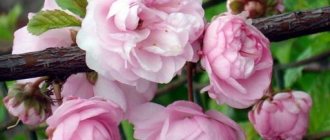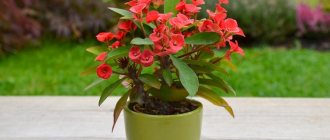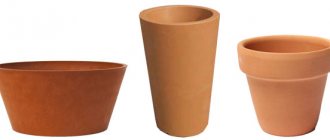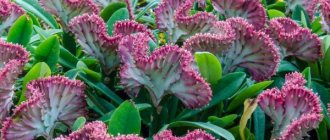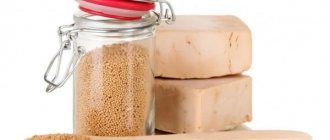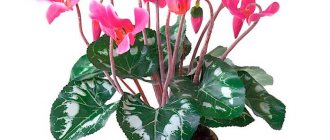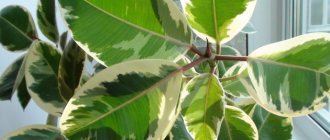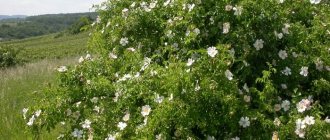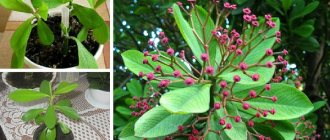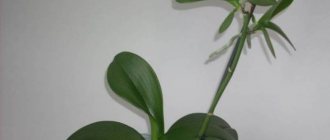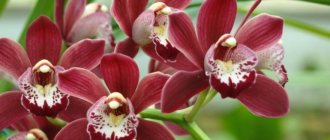Peculiarities
In winter, it is useful for all types of milkweed to have a dormant period. For flowering varieties this will promote intense flowering in the spring. Decorative deciduous species also need rest in winter.
Lighting in winter, even with artificial lighting, is insufficient for milkweed plants. Therefore, it cannot be kept at room temperature - it stretches out, its shoots become thinner.
During cold wintering, milkweed hardly grows and does not lose its decorative value.
Euphorbia contains caustic, poisonous white juice, which is released abundantly when cut.
If the juice gets into the eyes or just onto the skin, a burning sensation and severe irritation occurs. Therefore, when pruning or replanting a plant, you need to wear protective gloves.
Description of milkweed
Despite the differences in the shapes and sizes of the above-ground parts, all types of milkweed are united by one characteristic feature - light milky juice, with which their generic name is associated. It is by this that one can often determine whether a plant belongs to the Euphorbiaceae, although plants of other families may also contain similar juice. There are also euphorbias with clear juice. Despite the fact that the plant can be used in folk medicine, it is important to remember that milkweed juice is caustic and is considered poisonous. Contact with the skin can cause allergies, and ingestion can cause poisoning.
The shape and color of milkweed flowers depends on the species. Many of its varieties form cyathia inflorescences. The involucral leaves around pistillate flowers with several stamens are usually painted in different colors and resemble familiar flower petals. After flowering, fruit boxes are formed on the plant, each containing 3 seeds.
Some species of milkweed are grown as an oilseed crop. Thus, milkweed is common in Asian countries. Its seeds are used to obtain oil.
Trimming / Support / Garter
Pruning of the plant is carried out immediately after the end of its flowering . In different species this may be in the spring or even in mid-summer.
Species that do not bloom are also pruned in the spring before active growth begins.
When pruning, all dry branches are removed, living shoots are cut by 1/3 . All elongated thin shoots should be cut off, as they become fragile and can easily break.
To form a lush bush, leave 3-5 powerful shoots, which will give rise to new shoots.
Some types of milkweed are tied to a support for stability and to form a bend in the stem.
Planting and caring for milkweed
- Flowering: spring, first half of summer.
- Lighting: bright sunlight (windows facing southwest, southeast and south).
- Temperature: optimal in summer – 20-25 ˚C, in winter – 14-17 ˚C.
- Watering: abundant, after the substrate has dried to a quarter of the depth.
- Humidity: normal for residential premises.
- Feeding: during the active growing season, once every two weeks with complex fertilizer for cacti.
- Dormant period: for flowering euphorbias - after flowering, for decorative deciduous plants - in winter.
- Replanting: no more than once every two years, in the spring, at the beginning of active growth.
- Reproduction: seed and vegetative: depending on the type - by cuttings, shoots or dividing the bush.
- Pests: aphids, whiteflies, red spider mites, mealybugs, thrips, mosquitoes.
- Diseases: rot.
- Properties: milky juice of euphorbia is poisonous.
Read more about growing milkweed below.
Today, the awkward beauty of euphorbia has become very popular, and it is rare that an amateur gardener has not decorated his windowsill with this outlandish flower. Euphorbia (lat. Euphorbia) is a numerous (from 800 to 2000 according to various species data) genus of annual and perennial herbs, shrubs and trees of the Euphorbiaceae family. The spurge plant is native to the subtropical regions of Africa, Central and South America, Arabia, the Canary Islands and Madagascar. Euphorbia received the name “euphorbia” from the ancient Roman healer Dioscarides, who named the plant in honor of his colleague, the legendary Euphorbus, who owned the secrets of making medicines from milkweed and was mentioned in the works of Pliny himself.
It is difficult to describe the general appearance of euphorbias, since some species are very different from others: some have leafy stems and without thorns, others, on the contrary, have spiny stems without leaves; the stems also vary - fleshy or faceted, columnar or spherical... euphorbias have one characteristic in common – white milky sap of plants.
- Greens on the windowsill: growing on the windowsill
Diseases
Euphorbia is susceptible to various fungal diseases. Most often they occur due to too frequent watering or stagnation of water in the ground due to poor drainage. Their signs are yellowing and falling leaves, the appearance of dark spots on the stems.
To combat rotting, you need to spray spurge with fungicidal preparations..
Pests rarely attack milkweed, but sometimes red spider mites, scale insects, or mealybugs settle on it. Insecticidal preparations are used to kill pests.
Euphorbia in open ground
In the summer, potted plants can be moved outdoors. Some species are specially planted in open ground and grown as annual plants. Cypress and multicolored spurges overwinter well in the ground without shelter. And bordered spurge must be re-sown every year. It is better to do this through seedlings, rather than immediately sowing seeds in the ground.
In the garden the plant is as unpretentious as at home. Loves sunny places, grows in any soil. Garden plants are propagated by dividing the bush in spring and late summer. Euphorbia in the garden does not like frequent transplants; it slowly grows young shoots. Therefore, it is better to immediately plant the separated bushes in a permanent place.
Problems
Euphorbia may lose leaves due to insufficient nutrition. In this case, the plant needs to be fed with phosphorus-containing fertilizers and transplanted into new soil in the spring.
If only the lower leaves fall off, this indicates prolonged drying out of the soil , which should not be allowed. Also, prolonged drying can lead to wrinkling of the stem.
Lack of light often leads to stretching of the plant and darkening of young leaves. We must not forget that this plant loves the sun.
With abundant watering and low temperatures, the stem and root of milkweed rot . In this case, you need to dry the plant and treat it with fungicides.
The necessary conditions
Priming
Typically, White-leaved spurge is planted in a special substrate for succulents. You can prepare your own soil mixture from turf and leaf soil with the addition of coarse sand. Euphorbia is not demanding on fertility, but prefers slightly acidic soils.
Humidity
White-leafed spurge is undemanding to air humidity, but responds well to regular ventilation. It is important to avoid drafts. Once every few months, it is recommended to wash euphorbia under a lukewarm shower. When soiled, it is necessary to wipe the leaves from dust with damp cotton wool.
Temperature
The indoor flower loves warmth, tolerates temporary heat and drought, but is sensitive to cold. In summer it feels good at a temperature of 24-25°C, in winter – at 17-18°C. In the warm season, it is useful to take euphorbia to the balcony or loggia.
Illumination
To successfully grow milkweed you need good lighting. In the house it is better to place it on the south windows. In winter, artificial supplementary lighting is useful. In summer, it is advisable to place the indoor flower in the sun.
Reproduction
Various types of milkweed are propagated by seeds and cuttings. Species that do not bloom indoors are easier to propagate by cuttings. Species that do not produce shoots, such as spurge, reproduce only by seeds.
Seeds obtained from indoor plants are stored for no more than a year. After this they lose their viability. They are sown in a container with soil mixture in early spring. Large seeds are buried slightly into the ground, and the container is covered with film. The temperature for germination must be at least 22°C. The first shoots can be seen after 2-3 weeks.
Cuttings are cut when pruning the plant in spring or mid-summer (it is convenient to root apical cuttings).
Shoots for rooting must be at least 10 cm in length. The lower leaves are removed from them, dried for 1-2 days and planted in sand.
It is necessary to periodically moisten the sand, and the cuttings can be covered with glass. Usually after 3-4 weeks they take root and are transplanted into separate pots.
Kinds
Annual species of milkweed
There is neither time nor opportunity to describe all two thousand species of milkweed, but we will introduce you to several representatives of this genus popular among gardeners. So: of the annual euphorbias or of the perennials that are grown as annuals, the most famous are:
Euphorbia marginata
Erect stems up to 80 cm high, light green oval leaves up to 4 cm in length, acquiring a white border along the edge during flowering;
In the photo: Euphorbia marginata
Euphorbia heterophylla (Euphorbia heterophylla)
Height is 80-90 cm, the upper leaves are reddish, and large bracts by September acquire either a salmon or carmine color.
In the photo: Euphorbia heterophylla (Euphorbia heterophylla)
Perennial species of milkweed
To a greater extent, perennial species of euphorbia are cultivated in home floriculture. Here are a few of the most popular:
Euphorbia Milii
Or spurge spurge: not a succulent, but a large shrub with thorns, small leaves at the ends of the shoots, small flowers collected in red and sometimes yellow inflorescences;
In the photo: Euphorbia Milii (Euphorbia Milii)
White-veined spurge (Euphorbia leuconeura)
Or white-veined euphorbia: the leaves are dark green with white veins in a young plant gradually lose the white color of the veins, and over time the leaves grow only on the top of the euphorbia, which makes it look like an exotic palm tree with a thick leg;
In the photo: White-veined or white-veined milkweed (Euphorbia leuconeura)
Euphorbia trigona
Or Euphorbia triangular , or Euphorbia ribbed , is a stemmed succulent, shrub or tree with triangular stems and red-brown thorns. At home it grows above two meters. The leaves are lanceolate-pointed. There is a variety with crimson leaves and a reddish stem. At home, this spurge does not bloom;
In the photo: Triangular or triangular or ribbed spurge (Euphorbia trigona)
Cypress spurge (Euphorbia cyparissias)
In fact, this is a plant for gardens, because it grows like a weed. It is better to plant cypress spurge in a container and promptly remove seedlings from self-seeding. However, this milkweed grass is winter-hardy and tolerates drought well, and does not require watering or care;
In the photo: Cypress spurge (Euphorbia cyparissias)
Euphorbia Tirukalli
Or finger spurge - a very interesting species, a tree-like succulent with a large number of leafless, jointed shoots. The leaves fall off before they have time to grow. Euphorbia blooms very rarely with small, inconspicuous flowers. And it was from the very poisonous juice of this milkweed that rubber was extracted;
In the photo: Euphorbia Tirukalli or fingerweed
Fischer's Euphorbia (Euphorbia fischeriana)
Or Euphorbia Pallas, or man-root - a low plant with a juicy, thick and branched root, similar in appearance to ginseng root, and, most likely, this is what healers and sick people are looking for on the Internet. It is best to discuss methods of treatment with this root with a medical specialist;
- Hamedorrhea at home
In the photo: Euphorbia Pallas or Fischer or man-root (Euphorbia fischeriana)
Euphorbia caput medusae (Euphorbia caput medusae)
A plant with a stem thickened at the top and branches diverging in different directions. In fact, it’s an eerie sight: this species is so unusual that flower growers are happy to cultivate it, using it as an hanging plant in a hanging flowerpot from which “jellyfish tentacles” hang;
In the photo: Jellyfish's head spurge (Euphorbia caput medusae)
Beautiful spurge (Euphorbia pulcherrima)
One of the most spectacular euphorbias is poinsettia , or beautiful euphorbia . People call it the “Christmas star.” In nature, this species reaches three meters in height, and in indoor conditions it is one of the most beautiful plants that blooms in the middle of winter, which is why it is so popular on New Year's Eve and Christmas. The poinsettia flower is a bush 40-50 cm in height with erect stems and large leaves, similar to maple leaves, but elongated and pointed at the ends. Large bracts, shaped like leaves, are colored pink, white or red. Poinsettia blooms from two months to six months, then the bracts gradually turn green and fall off.
Transfer
The plant is replanted in the spring. Typically, young specimens up to 5 years of age are replanted annually, older ones – once every 2 years.
The root system of the plant is superficial, so it does not need a deep pot. The container for transplantation should be slightly larger than the previous one.
It is necessary to make a thick drainage layer in the pot for milkweed so that water leaves the soil and does not stagnate. Expanded clay or broken bricks are suitable for this purpose.
The roots of the plant are very fragile, so it is replanted by handling it so as not to damage the root system.
After transplantation, the flower is not watered for 2-3 days.
Transplanting at home into another pot
Before transplanting, you need to prepare a container, nutrient mixture and drainage. How to choose a pot:
- Choose a pot taking into account the fact that the roots grow quickly. There should be enough space to install high-quality drainage, 2-3 centimeters wider than its predecessor.
- But the container should not be spacious, because spurge is ready to take up the space around itself. You should not take a growing pot, or a very deep one, also because the water stagnates in such a pot and the roots rot.
When replanting, place a layer of drainage on the bottom of the pot. For good breathability, it is advisable to sprinkle the drainage with rotten tree bark. Pebbles, expanded clay, and crushed tiles serve as drainage.
If a tall plant is being transplanted, heavy stones should be placed at the bottom along with drainage. In this case, the pot will not turn over due to gravity. For milkweed, the soil should be loose, permeable, slightly acidic .
We prepare the soil in one of the following ways:
- We take the following ingredients: peat, turf soil, leaf soil, sand. Mix them in equal parts.
- Mix leaf soil (2 parts), humus (3 parts), sand (2 parts).
- Take a store-bought nutrient substrate for succulents.
If you doubt the quality of the purchased mixture, treat it with water with the addition of potassium permanganate.
The transplant process consists of the following steps:
- Before replanting, water your indoor plant to make it easier to remove.
- Carefully remove the flower from the pot, while using a knife to help separate the edges of the soil from the walls of the pot.
- Inspect the root system, remove damaged or rotten roots.
- Gently shake off excess soil, but do not overdo it so as not to injure the roots.
- Using the transfer method, carefully transfer the plant into a previously prepared pot with drainage placed on the bottom and a thin layer of prepared substrate.
- Sprinkle the spurge with prepared soil.
- Press the surface moderately firmly with your hands.
- Pour warm water with bait.
